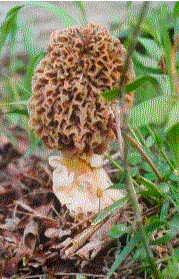Morel
|
|
| Morel | ||||||||||||
|---|---|---|---|---|---|---|---|---|---|---|---|---|
 | ||||||||||||
| Scientific classification | ||||||||||||
| ||||||||||||
| Species | ||||||||||||
|
Morchella angusticeps |
The morel is a famed type of edible cup fungus. The morel produces a highly porous ascocarp, greatly prized by gourmet cooks, particularly for French cuisine.
The best known morel is the Morchella deliciosa, which is commonly known as simply morel. Other types include Morchella esculenta, M. elata, M. semilibera, and M. vulgaris. Mushroom hunters will commonly refer to them by their color, i.e., gray, yellow, black, etc., as the species are very similar in appearance and vary considerably within species and age of individual mushroom.
The morel is the state mushroom of Minnesota.
When gathering morels, care must be taken to distinguish them from the poisonous false morel (Gyromitra esculenta and others). However, morels are fairly distinctive in appearance.
The morel grows abundantly in the two and sometimes three years immediately following a forest fire, but where fire suppression is practiced, may grow regularly though in small amount in the same spot year after year. These spots may be jealously guarded by mushroom pickers, as the mushrooms represent a cash crop. (There is some evidence that disturbance-following morels may be different species than those growing in relatively undisturbed sites, but genetic confirmation has not yet been accomplished.) Commercial pickers and buyers in North America will follow forest fires to gather morels. Morels have not yet been successfully farmed on a large scale, and the commercial morel industry is based on harvest of wild mushrooms.
See mushroom hunting.
Sources
Harvesting Morels After Wildfire in Alaska. Wurtz et al. USDA Forest Service Research Note PNW-RN-546, February 2005.
External links
- The Great Morel (http://www.bright.net/~wildwood)
- Wild Harvest (http://www.wild-harvest.com)de:Morchel
